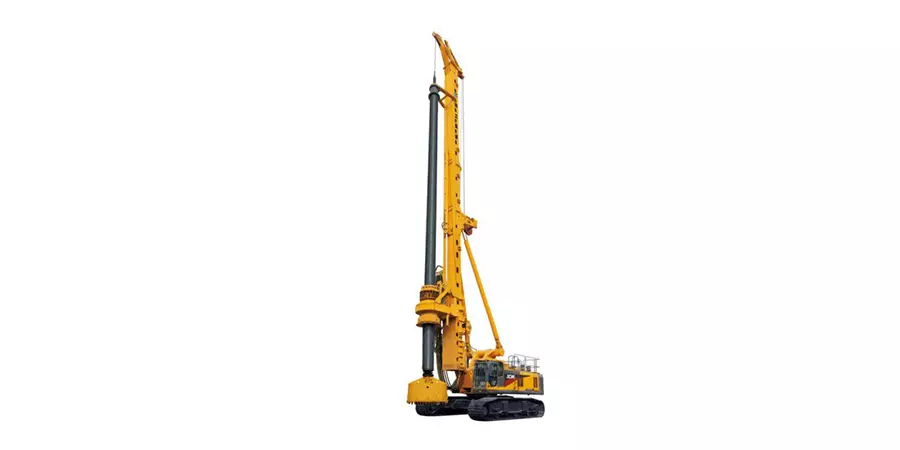Markets

Hydraulic Products Used in Rotary Drilling Rigs
Rotary drilling rigs rely on hydraulic systems to perform critical operations such as rotation, lifting, feeding, and stabilization. Below is a detailed breakdown of key hydraulic components and their roles in these specialized machines:
1. Hydraulic Pumps
Function: Provide pressurized hydraulic fluid to power the entire system.
Types:
Variable Displacement Axial Piston Pumps (e.g., Bosch Rexroth A4VG, Kawasaki K5V): Deliver high pressure (35–42 MPa) and adjustable flow for dynamic load demands.
Gear Pumps: Support auxiliary circuits (e.g., cooling or pilot systems).
Key Features:
Load-sensing (LS) technology to optimize energy efficiency.
High flow rates (300–600 L/min) for heavy-duty drilling operations.
2. Hydraulic Motors
Function: Drive rotational and linear movements.
Types:
Rotary Motors (e.g., axial piston motors): Power the rotary head for drill pipe rotation (e.g., 0–30 RPM for large rigs).
Travel Motors: Move the rig on tracks or wheels.
Winch Motors: Drive the hoisting system for raising/lowering the drill string.
Key Features:
High torque (up to 50,000 Nm) for rotation in hard rock formations.
Integrated brake systems for safety during hoisting.
3. Hydraulic Cylinders
Function: Provide linear force for drilling and stabilization.
Types:
Feed Cylinders: Control the vertical movement of the drill head (e.g., telescopic cylinders for deep drilling).
Mast Tilt Cylinders: Adjust the mast angle for precise positioning.
Stabilizer Cylinders: Deploy outriggers or stabilizers to level the rig.
Key Features:
Long stroke (up to 10+ meters) for deep-hole drilling.
Robust seals to withstand abrasive drilling mud and high pressures.
4. Main Control Valves
Function: Direct and regulate hydraulic flow to actuators.
Types:
Proportional Valves (e.g., electro-hydraulic): Enable precise control of rotation speed and feed force via joystick or PLC inputs.
Multi-Section Valves: Manage multiple functions (rotation, feed, hoisting) simultaneously.
Key Features:
Pressure-compensation to maintain consistent performance under varying loads.
Integrated safety valves to prevent overload during drilling.
5. Hydraulic Power Units (HPUs)
Function: Centralized system housing pumps, tanks, and filtration.
Components:
Hydraulic Reservoir: Large-capacity tank with air breathers and level sensors.
Cooling System: Air- or water-cooled radiators to maintain oil temperature (≤60°C).
Filtration: High-efficiency filters (10 μm or finer) to protect sensitive components from drilling mud contaminants.
6. Rotary Unions and Swivel Joints
Function: Transfer hydraulic fluid and electrical signals between rotating and stationary parts.
Key Applications:
Rotary Head Swivel: Enables continuous rotation of the drill pipe while supplying hydraulic power to the drill head.
Kelly Hose Rotary Joint: Connects hydraulic hoses to the rotating kelly bar.
Key Features:
High-pressure seals (≥40 MPa) to prevent leaks.
Corrosion-resistant materials (e.g., stainless steel) for harsh environments.
7. Auxiliary Hydraulic Systems
Hammer Circuits:
High-pressure circuits for hydraulic hammers or down-the-hole (DTH) drills in hard rock.
Includes accumulators to buffer pressure spikes.
Mud Pump Drives:
Hydraulic motors powering mud pumps for circulating drilling fluid.
Automatic Pipe Handling:
Hydraulic clamps and manipulators for automated drill pipe handling.
Specialized Components
Crowd and Feed Systems:
Hydraulic chains or rack-and-pinion systems to apply controlled downforce (up to 500 kN) during drilling.
Depth Control Valves:
Electronically controlled valves to maintain precise drilling depth and retraction speed.
Anti-Rotation Lock:
Hydraulic clamps to stabilize the drill string during tool changes.
Key Technologies
Load-Sensing Systems: Dynamically adjust pump output to match drilling demands, reducing energy waste.
Closed-Loop Control: Electro-hydraulic feedback for precise rotation speed and torque management.
Condition Monitoring: IoT sensors track hydraulic pressure, temperature, and contamination levels in real time.
Maintenance Challenges
Contamination Control: Drilling mud and dust require frequent filter changes (ISO 4406:2021 standards).
High-Pressure Seals: Regular inspection of rotary unions and cylinder seals to prevent leaks.
Heat Management: Ensure coolers and heat exchangers function optimally to avoid oil degradation.
Leading Manufacturers
Pumps/Valves: Bosch Rexroth, Parker Hannifin, Danfoss.
Cylinders: Enerpac, Hydac, Liebherr.
Rotary Unions: Deublin, Rotary Systems.
Summary
Rotary drilling rigs depend on a sophisticated hydraulic ecosystem to achieve precision, power, and reliability in demanding drilling applications. From high-torque rotary motors to intelligent control valves, each component plays a critical role in ensuring efficient operation. Advances in electro-hydraulic integration and predictive maintenance are driving the next generation of drilling rig performance.
